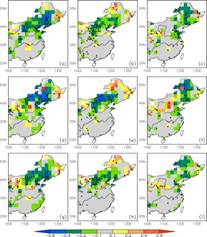Daily maximum (Tmax) and minimum (Tmin) surface air temperatures are closely tied to temperature extremes, which have attracted much attention due to their strong societal, economic, and ecological impacts. Previous studies mainly investigated summertime soil moisture–atmosphere interactions, when the surface latent heat flux tends to be large. The effects of soil moisture on mean daily maximum (Tmax) and minimum temperatures (Tmin) was statistically investigated over eastern China in spring (from March to May), summer (from June to August) and fall (from September to November), using the Global Land Data Assimilation System (GLDAS) soil moisture and observational temperatures. The study has been published in Meteorology and Atmospheric Physics, the lead author is Dr. Lingyun Wu at LASG and coauthor is Prof. Jingyong Zhang at CMSR.
The results show that soil moisture exerts asymmetric effects on Tmax and Tmin, thereby has substantial effects on the diurnal temperature range (DTR) in the three seasons. The soil moisture feedbacks on Tmax, Tmin, and DTR are found to evidently vary with season. In spring and summer, soil moisture exerts stronger negative forcing on Tmax than Tmin, and thus has negative effects on the DTR over many areas of northern China. In fall, soil moisture has much stronger positive effects on Tmin than Tmax, and thus has significant negative effects on the DTR over Northeast China and some areas of the climatic and ecological transition zone of northern China. The study discusses the possible physical mechanisms explaining the findings by dissecting the ability of soil moisture to affect surface air temperature into the ability of soil moisture to affect ET and the ability of ET to affect surface air temperature.
 Figure: JJA mean soil moisture feedback parameters [in oC (standardized soil moisture)-1] for left daily maximum, middle minimum and right diurnal range of surface air temperature for the period of 1979–2004: a–c CLM, d–f mosaic, and g–i Noah. Stations with values that achieve P<0.1 are marked by closed circles.
Figure: JJA mean soil moisture feedback parameters [in oC (standardized soil moisture)-1] for left daily maximum, middle minimum and right diurnal range of surface air temperature for the period of 1979–2004: a–c CLM, d–f mosaic, and g–i Noah. Stations with values that achieve P<0.1 are marked by closed circles.
More information at:
http://link.springer.com/search?sortOrder=newestFirst&facet-content-type=Article&facet-journal-id=703#page-1
